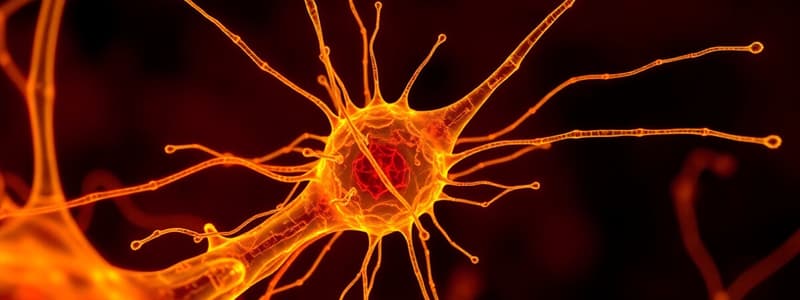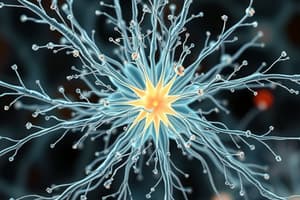Podcast
Questions and Answers
What is the primary role of microtubule-associated proteins (MAPs) in cellular functions?
What is the primary role of microtubule-associated proteins (MAPs) in cellular functions?
- To assist in the polymerization of actin filaments.
- To degrade microtubules into tubulin.
- To prevent depolymerization of microtubules and aid in intracellular transport. (correct)
- To initiate the synthesis of new microtubules from existing ones.
During which cellular process do centrioles contribute to the formation of the spindle apparatus?
During which cellular process do centrioles contribute to the formation of the spindle apparatus?
- Transcription
- Protein synthesis
- Cell division (correct)
- Cytokinesis
What mechanism allows kinesin to transport vesicles within the cell?
What mechanism allows kinesin to transport vesicles within the cell?
- Binding to actin filaments.
- Releasing chemical signals to attract the vesicle.
- Creating negative pressure within the vesicle.
- Utilizing energy derived from the hydrolysis of ATP. (correct)
How does colchicine exert its anti-inflammatory effects in acute gouty arthritis?
How does colchicine exert its anti-inflammatory effects in acute gouty arthritis?
The structure of centrioles is described as being composed of how many microtubule triplets?
The structure of centrioles is described as being composed of how many microtubule triplets?
Which statement best describes the dynamic nature of microtubules?
Which statement best describes the dynamic nature of microtubules?
What is the role of microtubules during cell division?
What is the role of microtubules during cell division?
How is the structure of microtubules related to their function?
How is the structure of microtubules related to their function?
What role do motor proteins play in relation to microtubules?
What role do motor proteins play in relation to microtubules?
Which of the following statements about microfilaments is most accurate?
Which of the following statements about microfilaments is most accurate?
Flashcards
Microtubule disruption by drugs
Microtubule disruption by drugs
Certain drugs interfere with microtubule assembly, altering cell functions in various ways
Colchicine's anti-inflammatory effect
Colchicine's anti-inflammatory effect
Colchicine prevents leukocyte movement and inflammation, aiming to stop gout
Microtubule-associated proteins (MAPs)
Microtubule-associated proteins (MAPs)
Proteins that help cell components move along microtubules
Centrioles' role in cell division
Centrioles' role in cell division
Signup and view all the flashcards
Dynein and Kinesin
Dynein and Kinesin
Signup and view all the flashcards
What are microtubules?
What are microtubules?
Signup and view all the flashcards
What is the centrosome?
What is the centrosome?
Signup and view all the flashcards
Tubulin subunits
Tubulin subunits
Signup and view all the flashcards
Why are microtubules dynamic?
Why are microtubules dynamic?
Signup and view all the flashcards
What is the role of microtubules in cell division?
What is the role of microtubules in cell division?
Signup and view all the flashcards
Study Notes
Cytoskeletal Microtubules & Microfilaments & Motility
- Students will be able to correlate the molecular organization of microtubules to their dynamic nature
- Interpret structural adaptations of microtubules to their function
- Correlate relevant motor proteins in cell trafficking to microtubules
- Appraise the importance of microtubules as a drug target
- Correlate the molecular structure of actin to its function
Cytoskeleton
- The cytoplasm of animal cells contains a cytoskeleton, a complex 3D network supporting cell shape
- It's actively involved in cellular motion, including organelles, vesicles, and even the whole cell
- The cytoskeleton includes: thin filaments (microfilaments), intermediate filaments, and microtubules.
Microtubules
- Microtubules (MTs) are long, hollow structures acting as intracellular pathways
- The centrosome, near the nucleus, has y-tubulin complexes that nucleate microtubules in a ring-shape fashion
- Microtubules are dynamic; constantly changing length via growth and shortening, primarily at their plus end (away from the nucleus)
- Average microtubule half-life is about 10 minutes
- Composed of 13 parallel protofilaments consisting of a- and b-tubulin heterodimers
Functions of MTs
- Maintain cell shape and rigidity
- Regulate movement of organelles and vesicles
- Enable intracellular transport; dynein moves vesicles towards the minus end, kinesin toward the plus end
- Create a structure for cilia and flagellum
- Involved in cell division; formation of the mitotic spindle
Clinical Correlation
- Drugs like colchicine can disrupt microtubule formation, affecting leukocyte migration and inflammatory responses, useful in treating conditions like gout
Microtubule-Associated Proteins (MAPs)
- Motor proteins assist in moving organelles and vesicles inside the cell
- Two major families are dynein and kinesin, moving along microtubules in opposite directions depending on ATP presence
Centrioles
- Cylindrical structures composed of nine microtubule triplets
- Part of the centrosome, a microtubule organizing center
- Essential for cell division by forming the spindle apparatus
- Associated with formation of cilia and flagella
Actin Filaments (Microfilaments)
- Composed of two coiled actin chains (F-actin) made from globular actin (G-actin) monomers
- Possess a plus end (faster-growing) and a minus end (slower-growing)
- Form different structures:
- Contractile bundles: Parallel, loosely-arranged filaments involved in cytokinesis, organelle movement, and endocytosis
- Gel-like networks: Provide structural integrity (cell cortex)
- Bundles: Found in microvilli
- Focal points: Points of contact with the extracellular matrix
Studying That Suits You
Use AI to generate personalized quizzes and flashcards to suit your learning preferences.
Related Documents
Description
This quiz explores the organization and function of microtubules and microfilaments within the cytoskeleton. Students will learn about their structural adaptations and roles in cellular motility, as well as their potential as drug targets. Enhance your understanding of these vital components in cellular architecture and dynamics.




